Evaluation of Forward Models for GNSS Radio Occultation Data Processing and Assimilation
Abstract
:1. Introduction
1.1. FM Algorithm in Data Assimilation and RO Data Processing
1.2. FM Algorithm
2. Experiments
2.1. Data, Collocation, and Quality Control
2.1.1. Data
2.1.2. Spatial and Temporal Collocation
2.1.3. Quality Control
2.2. Experiment 1: Algorithm Comparison
2.3. Experiment 2: Evaluation of Errors of FMs on the Fixed Model Level
3. Results
3.1. Experiment 1: Algorithm Comparison
3.1.1. Difference Analysis for Direct and Exp
3.1.2. Relative Difference Analysis of Direct and Exp Algorithms
3.1.3. Analysis to exp_T
3.2. Experiment 2: Evaluation of the Error of the FM on the Fixed Model Level
4. Discussion
Author Contributions
Funding
Data Availability Statement
Acknowledgments
Conflicts of Interest
Appendix A. Abel Integral Algorithms
Appendix A.1. Spherically Symmetric Assumption

A.2. Abel Integral
A.2.1. Direct Algorithm
A.2.2. Exp Algorithm
A.2.3. Exp_T Algorithm
Appendix B. Figures
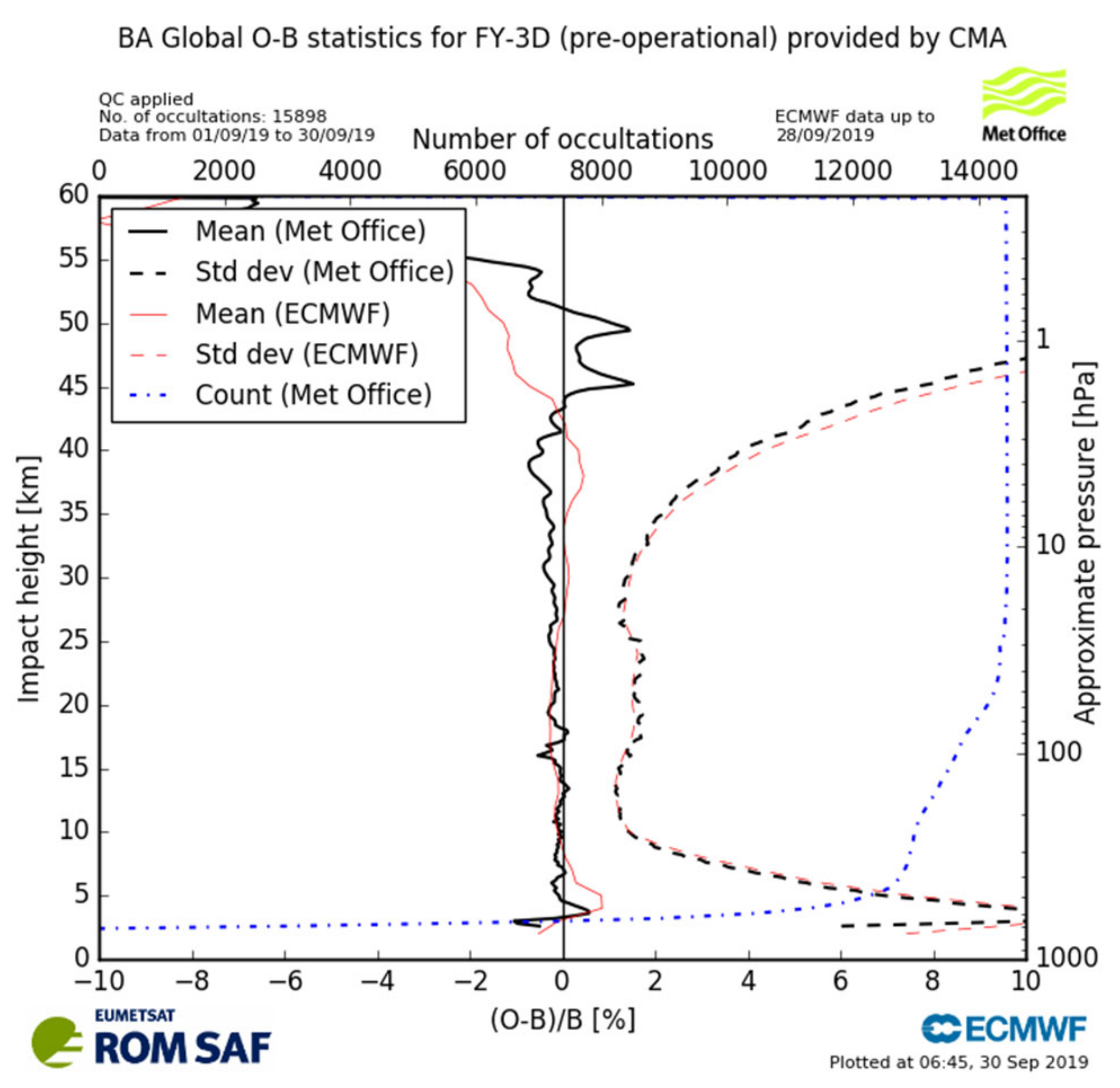

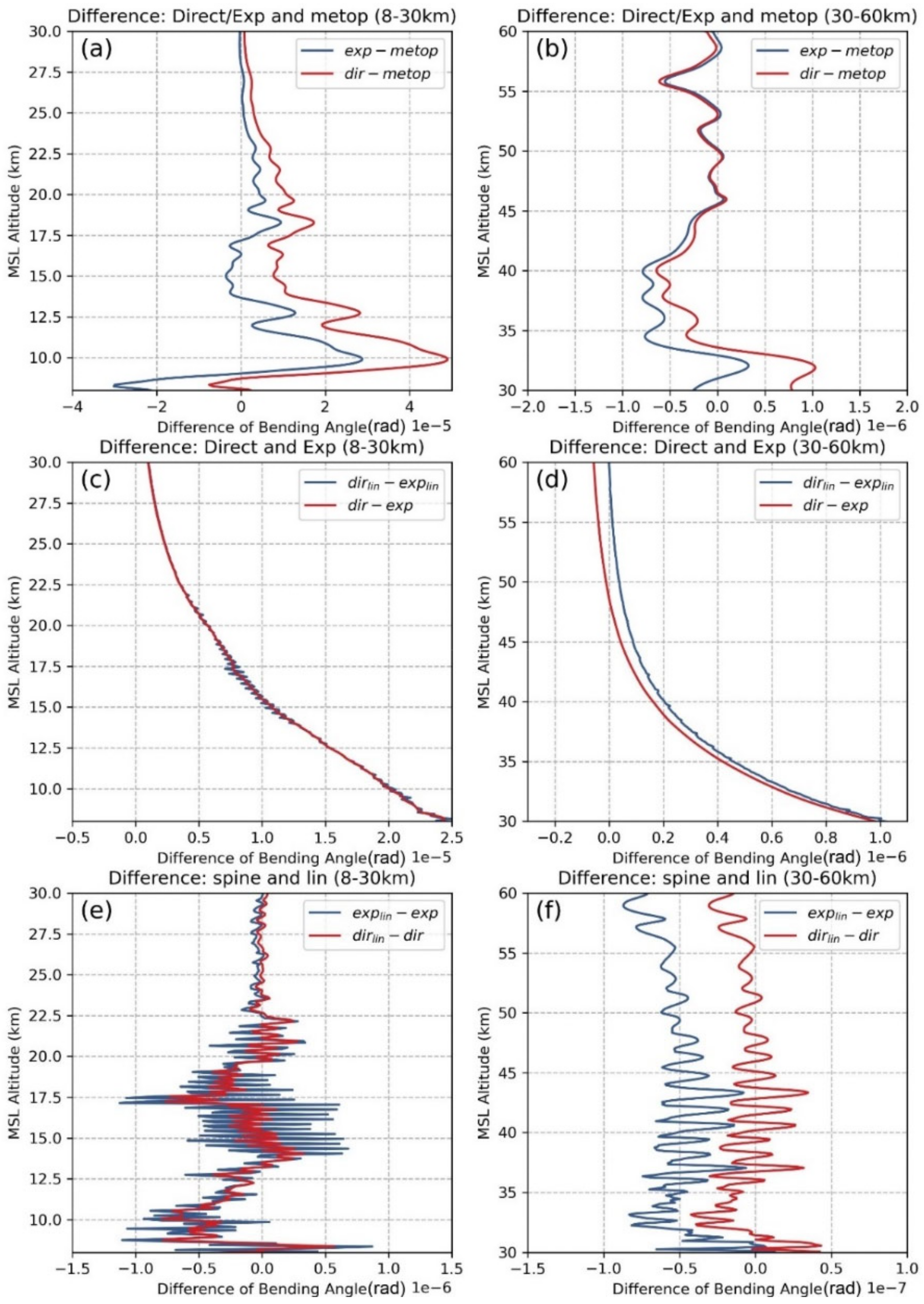
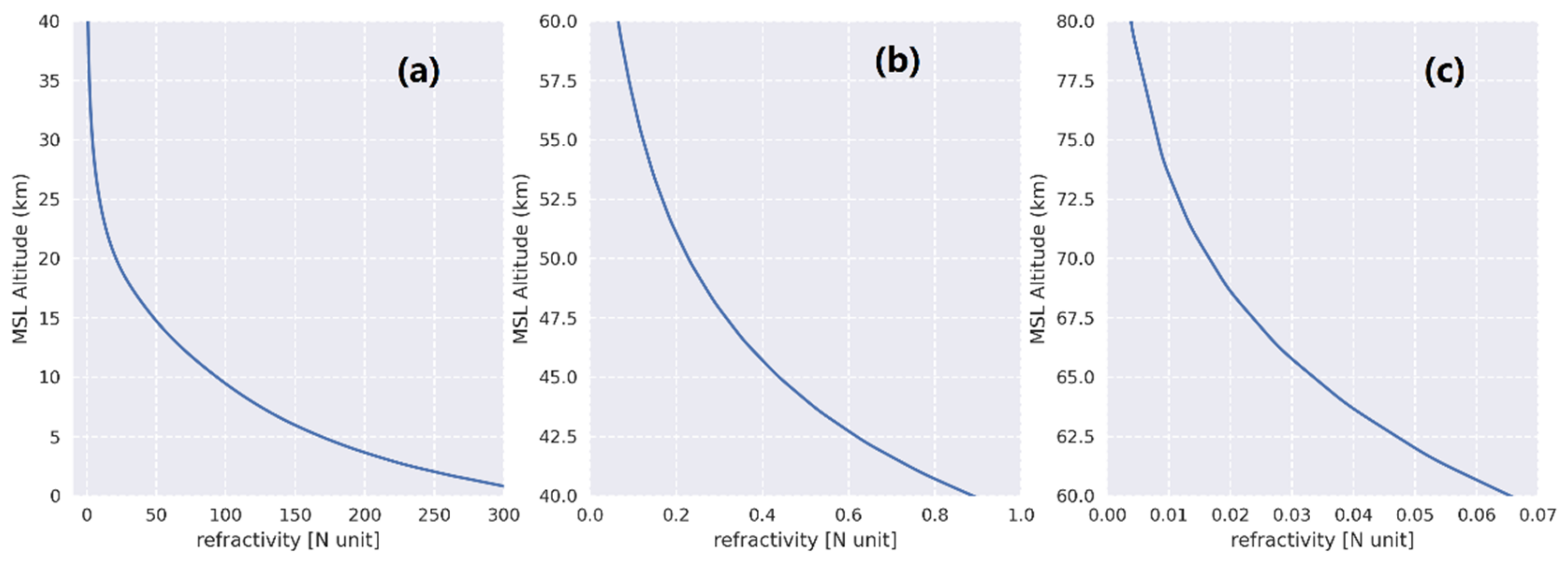

Appendix C. 4QC
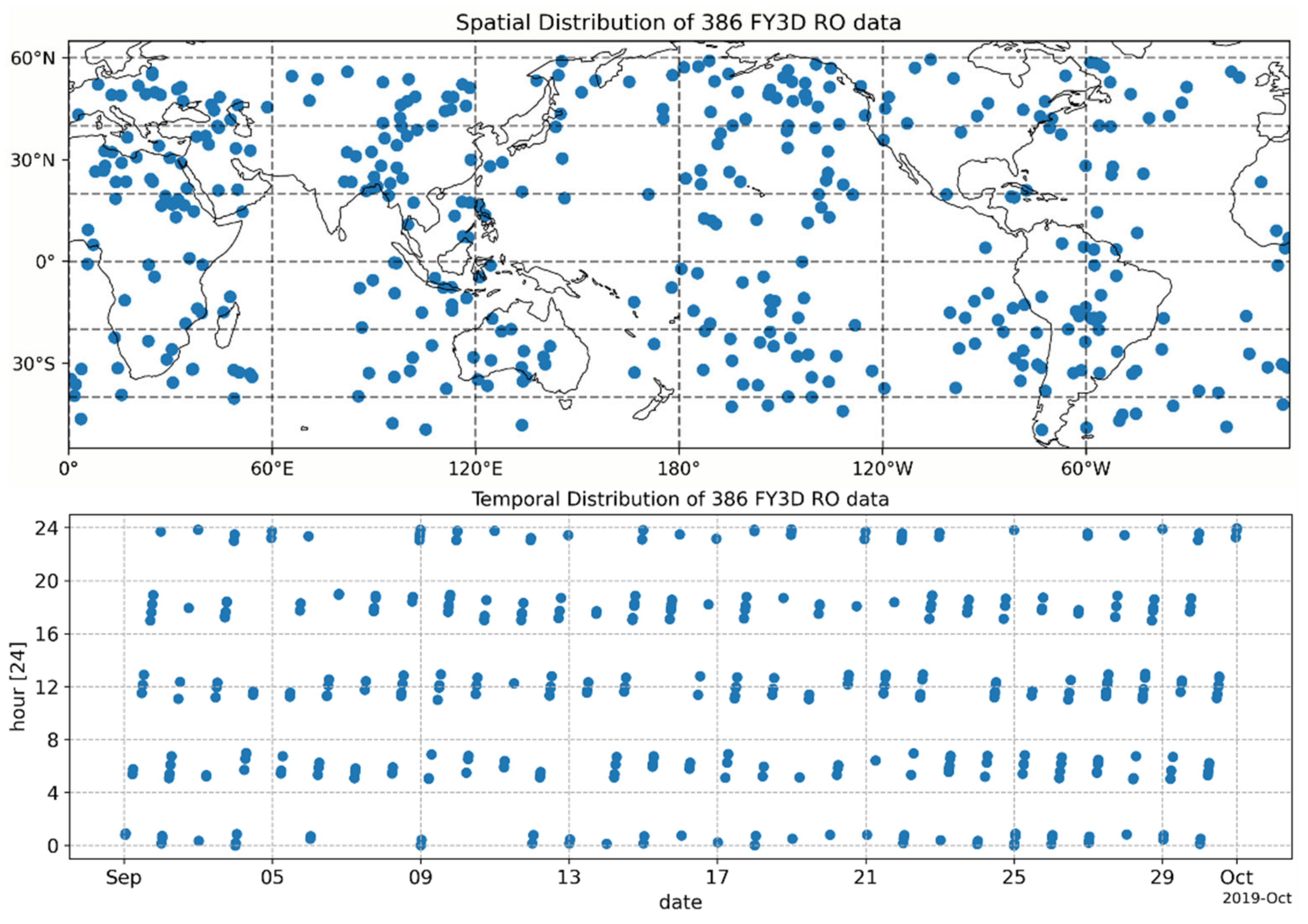

References
- Cardinali, C.; Healy, S. Impact of Gps Radio Occultation Measurements in the Ecmwf System Using Adjoint-Based Diagnostics. Q. J. R. Meteorol. Soc. 2014, 140, 2315–2320. [Google Scholar] [CrossRef]
- Sun, Y.; Bai, W.; Liu, C.; Yan, L.; Du, Q.; Wang, X.; Yang, G.; Mi, L.; Yang, Z.; Zhang, X. The Fengyun-3c Radio Occultation Sounder Gnos: A Review of the Mission and Its Early Results and Science Applications. Atmos. Meas. Tech. 2018, 11, 5797–5811. [Google Scholar] [CrossRef] [Green Version]
- Schreiner, W.S.; Weiss, J.P.; Anthes, R.A.; Braun, J.; Chu, V.; Fong, J.; Hunt, D.; Kuo, Y.; Meehan, T.; Serafino, W.; et al. Cosmic-2 Radio Occultation Constellation: First Results. Geophys. Res. Lett. 2020, 47. [Google Scholar] [CrossRef]
- Bai, W.; Tan, G.; Sun, Y.; Xia, J.; Cheng, C.; Du, Q.; Wang, X.; Yang, G.; Liao, M.; Liu, Y.; et al. Comparison and Validation of the Ionospheric Climatological Morphology of Fy3c/Gnos with Cosmic During the Recent Low Solar Activity Period. Remote Sens. 2019, 11, 2686. [Google Scholar] [CrossRef] [Green Version]
- Liao, M.; Healy, S.; Zhang, P. Processing and Quality Control of Fy-3c gnos Data Used in Numerical Weather Prediction Applications. Atmos. Meas. Tech. 2019, 12, 2679–2692. [Google Scholar] [CrossRef] [Green Version]
- Oscar. Available online: https://www.wmo-sat.info/oscar/gapanalyses?mission=9 (accessed on 15 August 2021).
- Bai, W.; Deng, N.; Sun, Y.; Du, Q.; Xia, J.; Wang, X.; Meng, X.; Zhao, D.; Liu, C.; Tan, G.; et al. Applications of Gnss-Ro to Numerical Weather Prediction and Tropical Cyclone Forecast. Atmosphere 2020, 11, 1204. [Google Scholar] [CrossRef]
- Harnisch, F. Scaling of Gnss Radio Occultation Impact with Observation Number Using an Ensemble of Data Assimilations. Mon. Weather. Rev. 2013, 141, 4395–4413. [Google Scholar] [CrossRef]
- ECMWF Observation Monitoring. Available online: https://www.ecmwf.int/en/forecasts/charts/obstat/gpsro_gpsro__count_0001_plot_o_count_gpsro_gpsro?facets=Parameter,Bending%20angles&time=2021062100&Phase=Setting (accessed on 22 June 2021).
- Bowler, N.E. An Assessment of Gnss Radio Occultation Data Produced by Spire. Q. J. R. Meteorol. Soc. 2020, 146, 3772–3788. [Google Scholar] [CrossRef]
- Bai, W.; Sun, Y.; Du, Q.; Yang, G.; Yang, Z.; Zhang, P.; Bi, Y.; Wang, X.; Wang, D.; Meng, X. An Introduction to FY3 GNOS in-Orbit Performance and Preliminary Validation Results. In Proceedings of the EGU General Assembly Conference, Vienna, Austria, 27 April–2 May 2014. [Google Scholar]
- Bai, W. An Introduction to the Fy3 Gnos Instrument and Mountain-Top Tests. Atmos. Meas. Tech. 2014, 7, 1817–1823. [Google Scholar] [CrossRef] [Green Version]
- Liao, M. Preliminary Validation of the Refractivity from the New Radio Occultation Sounder Gnos/Fy-3c. Atmos. Meas. Tech. 2016, 9, 781–792. [Google Scholar] [CrossRef] [Green Version]
- Steiner, A.K.; Ladstädter, F.; Ao, C.O.; Gleisner, H.; Ho, S.; Hunt, D.; Schmidt, T.; Foelsche, U.; Kirchengast, G.; Kuo, Y.; et al. Consistency and Structural Uncertainty of Multi-Mission Gps Radio Occultation Records. Atmos. Meas. Tech. 2020, 13, 2547–2575. [Google Scholar] [CrossRef]
- Bi, Y.; Yuan, B.; Wang, Y.; Ma, G.; Zhang, P. Assimilation experiment of GPS bending angle using WRF model — analysis of impact on Typhoon “SinLaku”. J. Tropical Meteorol. 2013, 29, 149–154. [Google Scholar]
- Gorbunov, M.; Stefanescu, R.; Irisov, V.; Zupanski, D. Variational Assimilation of Radio Occultation Observations into Numerical Weather Prediction Models: Equations, Strategies, and Algorithms. Remote Sens. 2019, 11, 2886. [Google Scholar] [CrossRef] [Green Version]
- Bai, W.; Tan, G.; Sun, Y.; Xia, J.; Du, Q.; Yang, G.; Meng, X.; Zhao, D.; Liu, C.; Cai, Y.; et al. Global Comparison of F2-Layer Peak Parameters Estimated by Iri-2016 with Ionospheric Radio Occultation Data During Solar Minimum. IEEE Access 2021, 9, 8920–8934. [Google Scholar] [CrossRef]
- Liu, C.; Kirchengast, G.; Syndergaard, S.; Schwaerz, M.; Danzer, J.; Sun, Y. New higher-order correction of GNSS RO bending angles accounting for ionospheric asymmetry: Evaluation of performance and added value. Remote Sens. 2020, 12, 3637. [Google Scholar]
- Gorbunov, M.E. Ionospheric Correction and Statistical Optimization of Radio Occultation Data. Radio Sci. 2002, 37, 1–9. [Google Scholar] [CrossRef] [Green Version]
- Hedin, A.E. Extension of the Msis Thermosphere Model into the Middle and Lower Atmosphere. J. Geophys. Res. Space Phys. 1991, 96, 1159–1172. [Google Scholar] [CrossRef]
- Scherllin-Pirscher, B.; Syndergaard, S.; Foelsche, U.; Lauritsen, K.B. Generation of a Bending Angle Radio Occultation Climatology (Baroclim) and Its Use in Radio Occultation Retrievals. Atmos. Meas. Tech. 2015, 8, 109–124. [Google Scholar] [CrossRef] [Green Version]
- Hocke, K. Inversion of Gps Meteorology Data. In Paper presented at the Annales Geophysicae 1997. In Proceedings of the Annales Geophysicae, Vienna, Austria, 30 April 1997. [Google Scholar]
- Healy, S.B.; Thépaut, J.N. Assimilation Experiments with Champ Gps Radio Occultation Measurements. Q. J. R. Meteorol. Soc. 2006, 132, 605–623. [Google Scholar] [CrossRef]
- Burrows, C.; Healy, S.; Culverwell, I. Improvements to the Ropp Refractivity and Bending Angle Operators. 2013. Available online: https://www.romsaf.org/general-documents/rsr/rsr_15.pdf (accessed on 22 June 2021).
- Kursinski, E.R.; Hajj, G.A.; Schofield, J.T.; Linfield, R.P.; Hardy, K.R. Observing Earth’s Atmosphere with Radio Occultation Measurements Using the Global Positioning System. J. Geophys. Res. Atmos. 1997, 102, 23429–23465. [Google Scholar] [CrossRef]
- The ROM SAF Consortium, some. The Radio Occultation Processing Package (Ropp) Forward Model Module User Guide. 2019.
- Cucurull, L.; Derber, J.C.; Purser, R.J. A Bending Angle Forward Operator for Global Positioning System Radio Occultation Measurements. J. Geophys. Res. Atmos. 2013, 118, 14–28. [Google Scholar] [CrossRef]
- Gilpin, S.; Anthes, R.; Sokolovskiy, S. Sensitivity of Forward-Modeled Bending Angles to Vertical Interpolation of Refractivity for Radio Occultation Data Assimilation. Mon. Weather Rev. 2019, 147, 269–289. [Google Scholar] [CrossRef] [Green Version]
- Brenot, H.; Rohm, W.; Kačmařík, M.; Möller, G.; Sá, A.; Tondaś, D.; Rapant, L.; Biondi, R.; Manning, T.; Champollion, C. Cross-Comparison and Methodological Improvement in Gps Tomography. Remote. Sens. 2019, 12, 30. [Google Scholar] [CrossRef] [Green Version]
- Xu, X.; Zou, X. Comparison of Metop-A/-B GRAS Radio Occultation Data Processed by CDAAC and ROM. GPS Solut. 2020, 24, 1–16. [Google Scholar] [CrossRef]
- Zou, X.; Zeng, Z. A Quality Control Procedure for Gps Radio Occultation Data. J. Geophys. Res. 2006, 111, 111. [Google Scholar] [CrossRef] [Green Version]
- Lohmann, M.S. Analysis of Global Positioning System (Gps) Radio Occultation Measurement Errors Based on Satellite De Aplicaciones Cientificas-C (Sac-C) Gps Radio Occultation Data Recorded in Open-Loop and Phase-Locked-Loop Mode. J. Geophys. Res. 2007, 112, 112. [Google Scholar] [CrossRef] [Green Version]
- Savitzky, A.; Golay, M.J.E. Smoothing and Differentiation of Data by Simplified Least Squares Procedures. Anal. Chem. 1964, 36, 1627–1639. [Google Scholar] [CrossRef]
- Orszag, S.A. On the Elimination of Aliasing in Finite-Difference Schemes by Filtering High-Wavenumber Components. J. Atmos. Sci. 1971, 28, 1074. [Google Scholar] [CrossRef] [Green Version]
- Lewis, H. Abel Integral Calculations in Ropp. 2008. Available online: https://www.romsaf.org/general-documents/gsr/gsr_04.pdf (accessed on 22 June 2021).
- Burrows, C.P.; Healy, S.B.; Culverwell, I.D. Improving the Bias Characteristics of the Ropp Refractivity and Bending Angle Operators. Atmos. Meas. Tech. 2014, 7, 3445–3458. [Google Scholar] [CrossRef] [Green Version]
- Fjeldbo, G.; Kliore, G.; Eshleman, V. The Neutral Atmosphere of Venus as Studied with the Mariner V Radio Occultation Experiments. Astron. J. 1970, 76, 123. [Google Scholar] [CrossRef]
- Yan, H.; Fu, Y.; Hong, Z. Spaceborne Gps Meteorology and Retrieval Technique (Chinese Version); Science and technology of China Press: Beijing, China, 2007. [Google Scholar]
- Jin, S.; Cardellach, E.; Xie, F. Gnss Remote Sensing; Springer: Berlin/Heidelberg, Germany, 2014; Volume 16. [Google Scholar]
- Marquardt, C.; Healy, S.; Luntama, J.; McKernan, E. GRAS Level 1 B Product Validation with 1d-Var Retrieval. EUMETSAT: Darmstadt, Germany, 2004. [Google Scholar]
- Hickstein, D.D.; Gibson, S.T.; Yurchak, R.; Das, D.D.; Ryazanov, M. A Direct Comparison of High-Speed Methods for the Numerical Abel Transform. Rev. Sci. Instrum. 2019, 90, 065115. [Google Scholar] [CrossRef]
- Schweitzer, S.; Pirscher, B.; Pock, M.; Ladstädter, F.; Borsche, M.; Foelsche, U.; Fritzer, J.; Kirchengast, G. End-to-End Generic Occultation Performance Simulation and Processing System Egops: Enhancement of Gps Ro Data Processing and Ir Laser Occultation Capabilities. University of Graz, Graz, Austria: Wegener Center for Climate and Global Change (WegCenter). 2008. Available online: http://wegcwww.uni-graz.at/publ/wegcpubl/arsclisys/2008/igam7www_sschweitzeretal-wegctechrepfffg-alr-no1-2008.pdf (accessed on 22 June 2021).
- Sheng, F.X. Atmospheric Physics; Peking University Press: Beijing, China, 2013. [Google Scholar]
- Lewis, H. Error Function Calculation in Ropp. 2007. Available online: https://www.romsaf.org/general-documents/gsr/gsr_04.pdf (accessed on 22 June 2021).
- Lanzante, J.R.R. Robust and Non-Parametric Techniques for the Analysis of Climate Data: Theory and Examples, Including Applications to Historical Radiosonde Station Data. Int. J. Climatol. A J. R. Meteorol. Soc. 1996, 16, 1197–1226. [Google Scholar] [CrossRef]
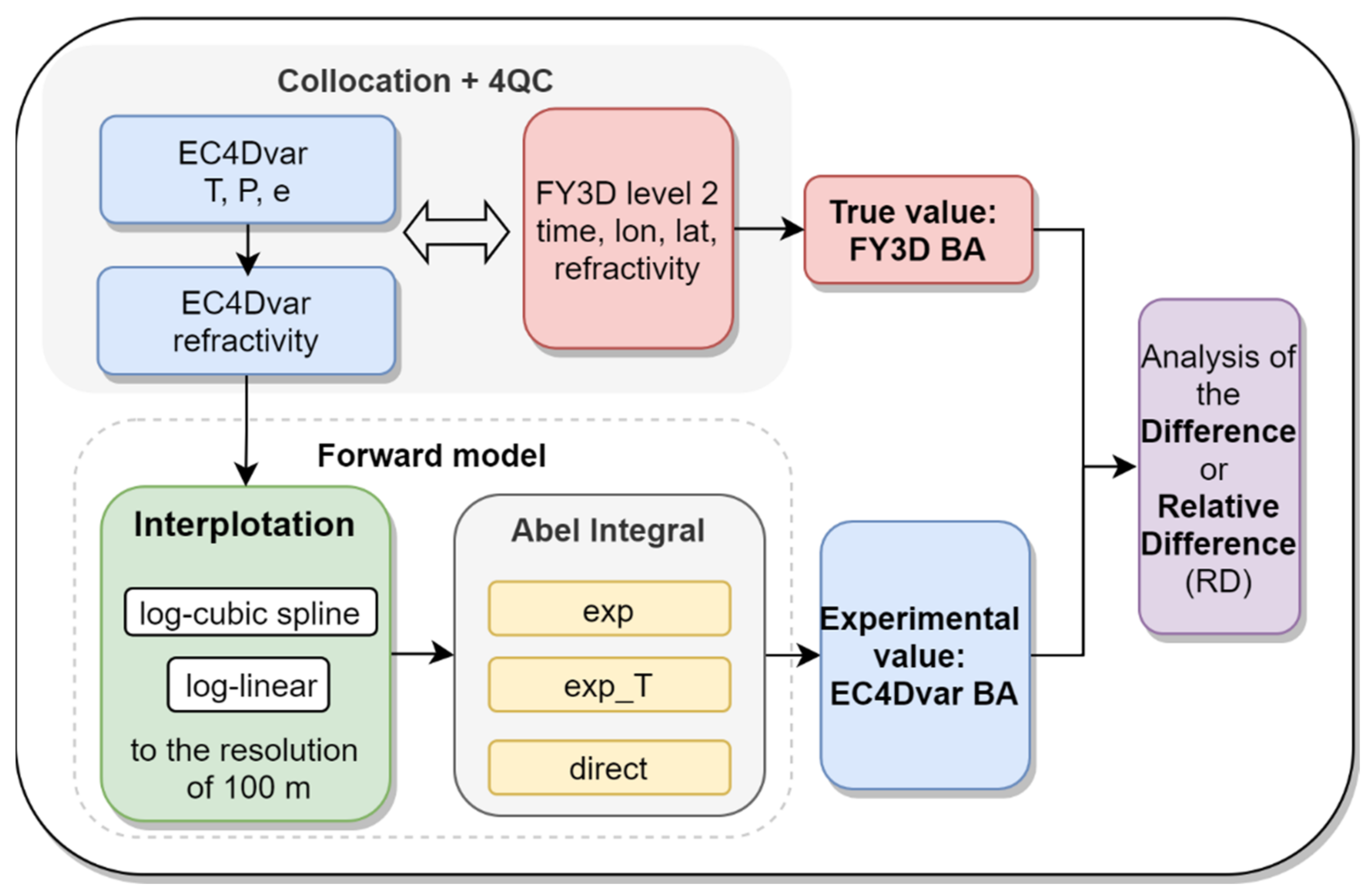
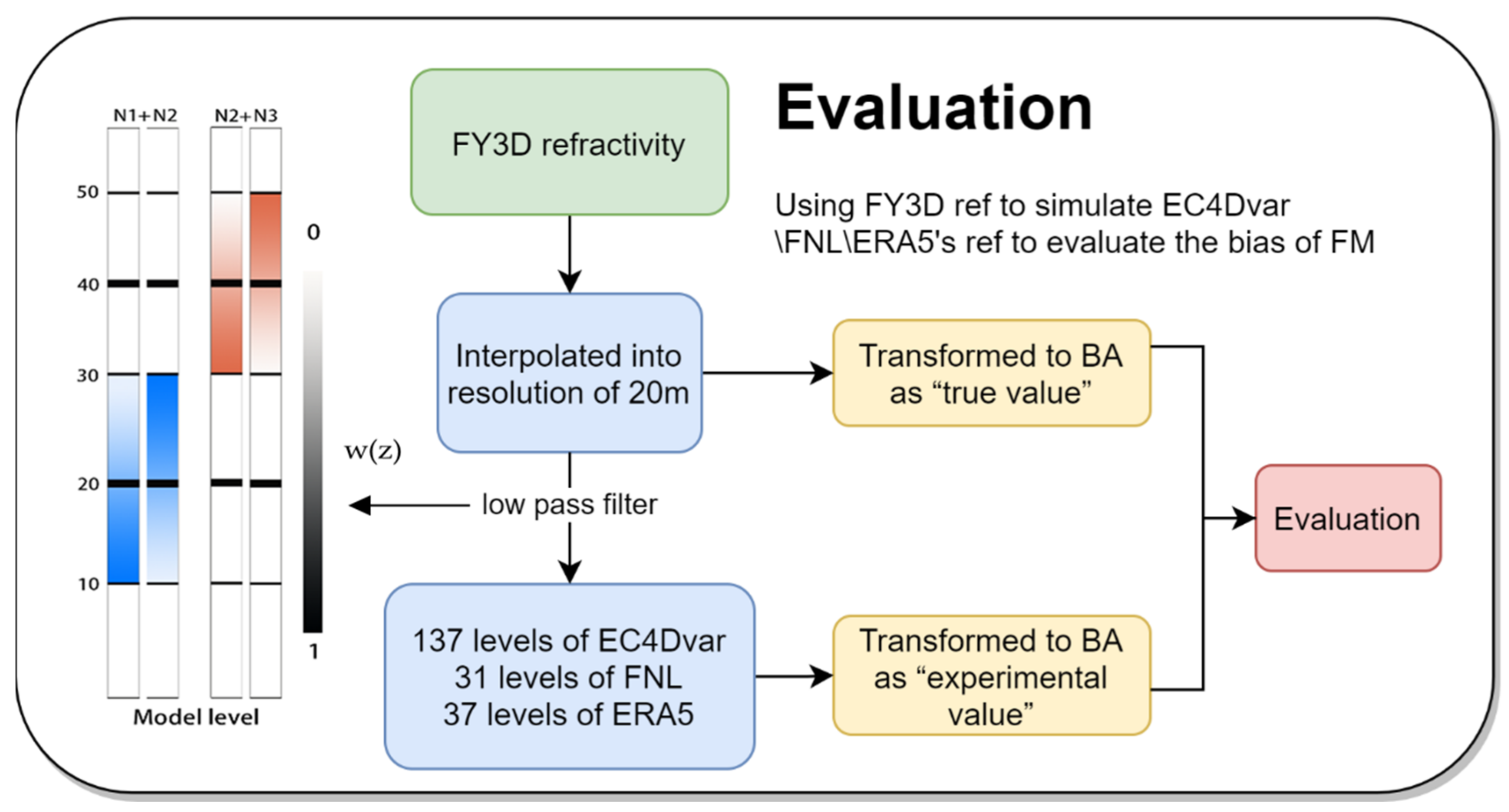
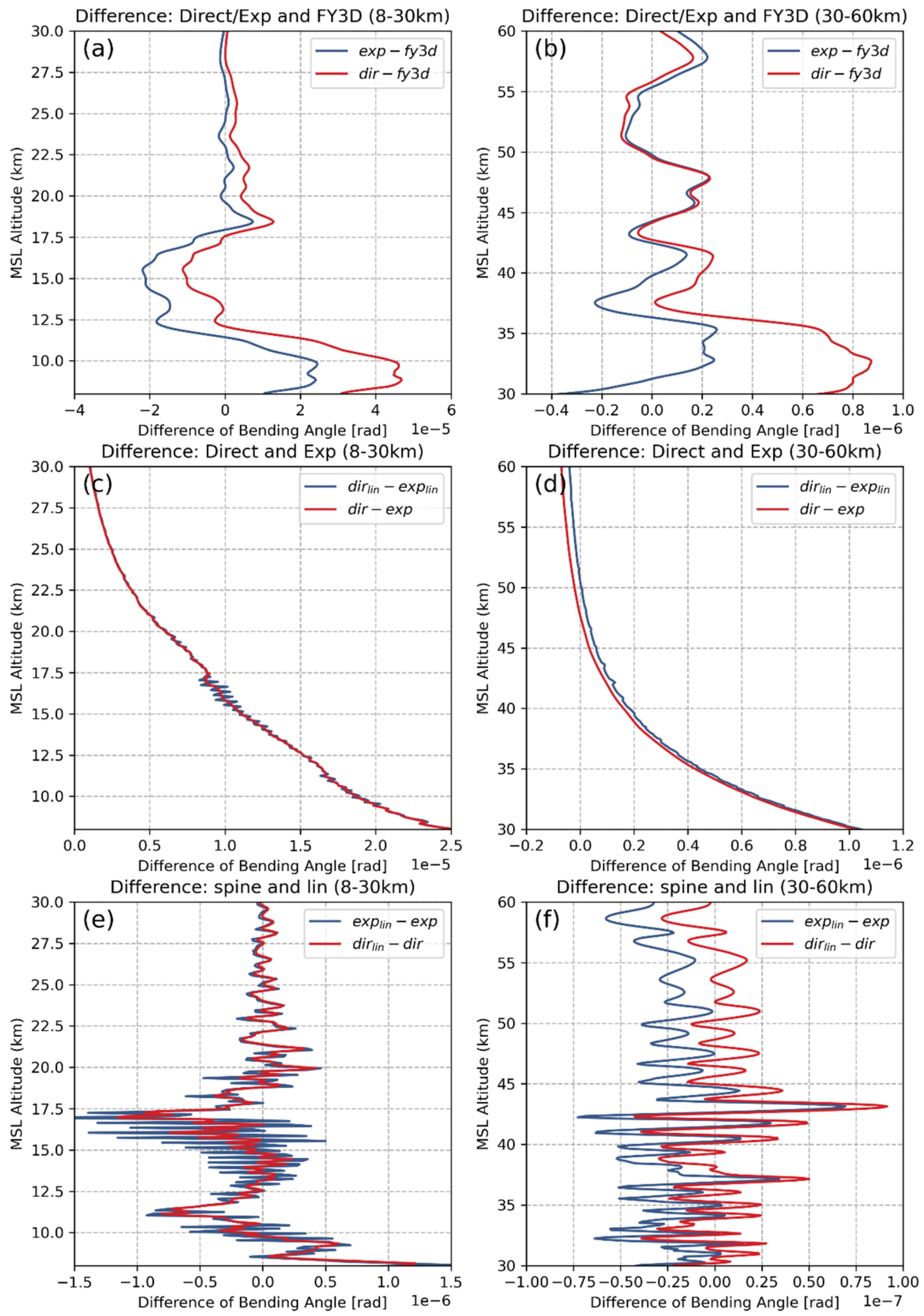

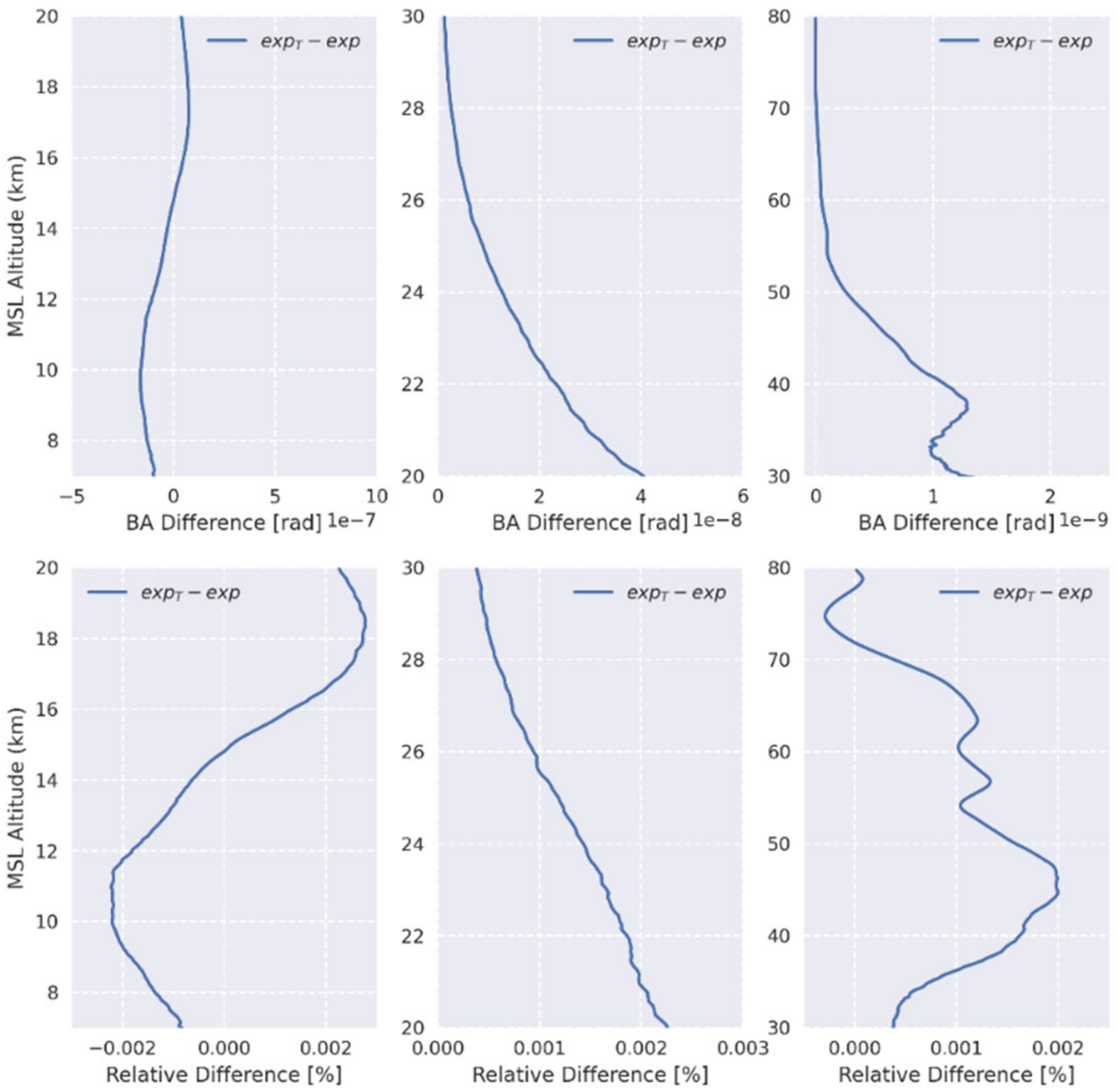
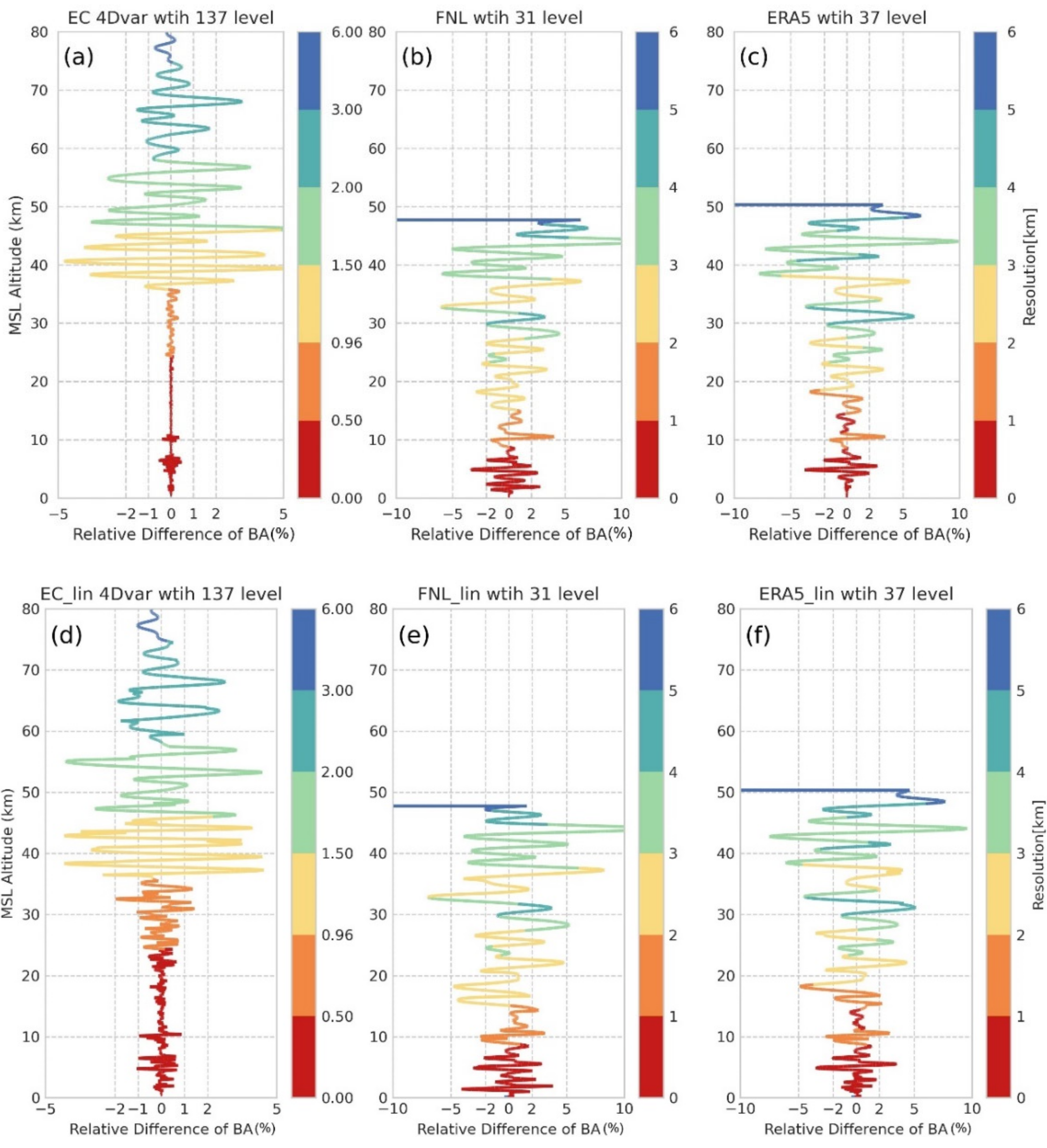

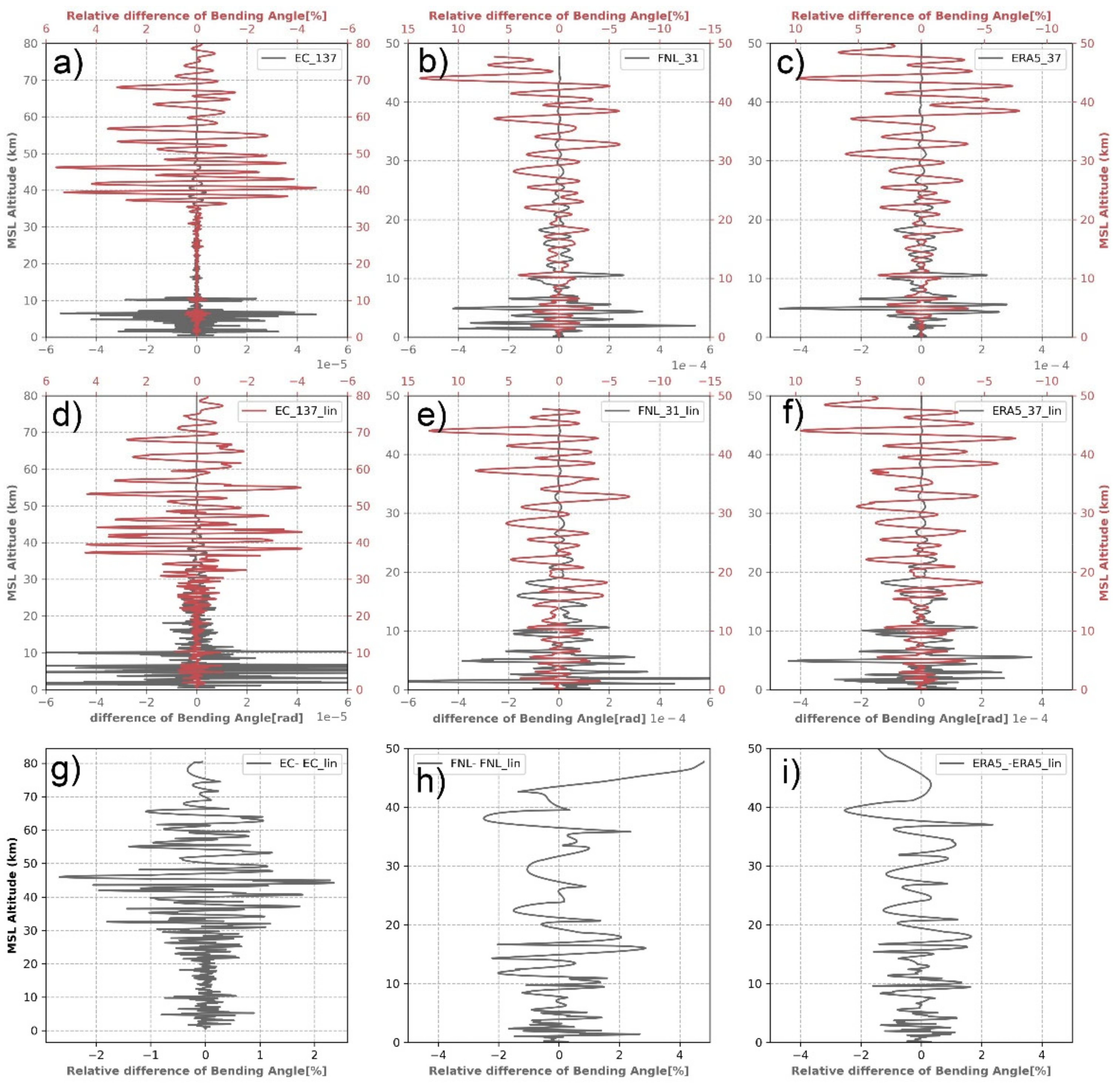
| H (km) | exp (%) | exp_lin(%) | direct(%) | direct_lin(%) | exp_T(%) | exp_T_lin(%) |
|---|---|---|---|---|---|---|
| 8–15 | (−0.3, 0.5) | exp + 0.3 | exp ± 0.002 | exp_lin ± 0.002 | ||
| 15–20 | (0.5, 1) | exp + 0.3 | ||||
| 20–45 | (−0.3, 0.5) | exp + 0.2 | ||||
| 45–55 | (−0.5, 1.5) | exp + 0.1 | ||||
| 55–60 | (0, 5) | (0, 4) | (0, 3.8) | |||
| 60–70 | (−1, 2.5) | (−4, 2.3) | (−10, 1.8) | |||
| 70–80 | (−1, 5) | (−20, −5) | (−80, −10) | direct + 4% | ||
| Statistics | MSL Height (km) | Order of Magnitude | EC 4Dvar (cubic) | EC 4Dvar (lin) | Msl Height (km) | FNL(31) (cubic) | ERA5(37) (cubic) |
|---|---|---|---|---|---|---|---|
| Relative difference (RD) | 0–35 | % | 0.5% | 1% | 0–30 | 2.5% | 3% |
| 35–58 | 4% | 4% | 30–40 | 5% | 5% | ||
| 58–80 | 1.8% | 2% | 40–50 | 15% | 10% | ||
| Difference | 0–10 | 1 × 10−5 | 4 × 10−5 | 6 × 10−5 | 0–11 | 4 × 10−4 | 2 × 10−4 |
| 10–35 | 1 × 10−6 | 2 × 10−6 | 8 × 10−6 | 11–22 | 4 × 10−5 | 5 × 10−5 | |
| 35–50 | 1 × 10−6 | 3 × 10−6 | 4 × 10−6 | 22–40 | 2 × 10−5 | 2 × 10−5 | |
| 50–60 | 1 × 10−7 | 2 × 10−7 | 4 × 10−7 | 40–46 | 2 × 10−6 | 2 × 10−6 | |
| 60–80 | 1 × 10−7 | 4 × 10−8 | 6 × 10−8 | 46–50 | 6 × 10−6 | 6 × 10−6 |
Publisher’s Note: MDPI stays neutral with regard to jurisdictional claims in published maps and institutional affiliations. |
© 2022 by the authors. Licensee MDPI, Basel, Switzerland. This article is an open access article distributed under the terms and conditions of the Creative Commons Attribution (CC BY) license (https://creativecommons.org/licenses/by/4.0/).
Share and Cite
Deng, N.; Bai, W.; Sun, Y.; Du, Q.; Xia, J.; Wang, X.; Liu, C.; Cai, Y.; Meng, X.; Yin, C.; et al. Evaluation of Forward Models for GNSS Radio Occultation Data Processing and Assimilation. Remote Sens. 2022, 14, 1081. https://doi.org/10.3390/rs14051081
Deng N, Bai W, Sun Y, Du Q, Xia J, Wang X, Liu C, Cai Y, Meng X, Yin C, et al. Evaluation of Forward Models for GNSS Radio Occultation Data Processing and Assimilation. Remote Sensing. 2022; 14(5):1081. https://doi.org/10.3390/rs14051081
Chicago/Turabian StyleDeng, Nan, Weihua Bai, Yueqiang Sun, Qifei Du, Junming Xia, Xianyi Wang, Congliang Liu, Yuerong Cai, Xiangguang Meng, Cong Yin, and et al. 2022. "Evaluation of Forward Models for GNSS Radio Occultation Data Processing and Assimilation" Remote Sensing 14, no. 5: 1081. https://doi.org/10.3390/rs14051081






